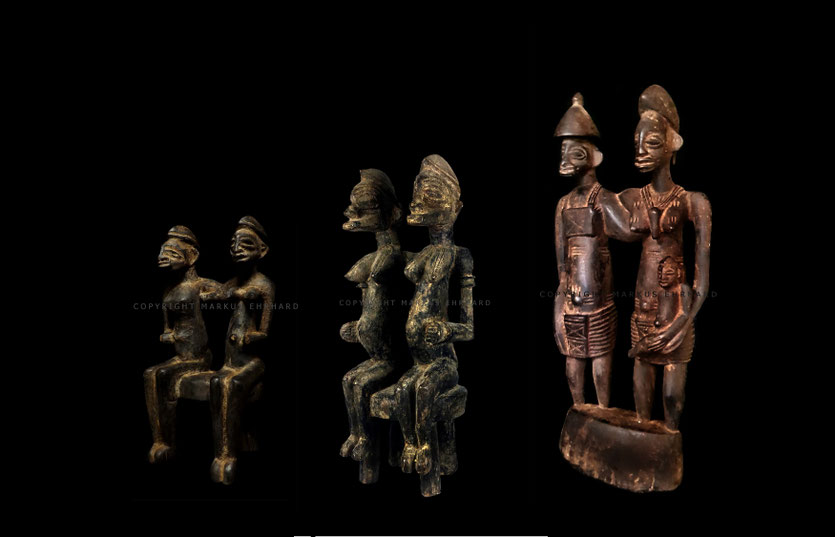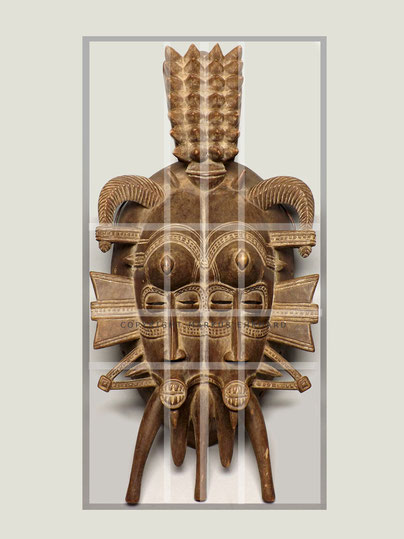09. Februar 2021
Similar to a scepter the dancer of the Kpelié mask does hold a stick in one of his hands and leads the ceremony with it. Karl-Heinz Krieg named this stick "Kumbol", and the Kufulo (or Koufouloh), a sub-group of the Senufo living south of Korhogo, name it "Jumbol". There is always a sitting female Tugubele statue on a semi circle shaped base that is placed on top of the stick. The lenght of this ceremonial accessory varies from short version of about 20 cm up to 60 cm long sticks. They can be...
Senufo · 14. Januar 2021
Quite often, objects of daily use receive a design at the Senufo culture. We know beer spoons or the heddle pulleys that have little Tugubele statues or the Calao bird featured. The Senufo love elegance, so beside the fact, that these features have a spiritual meaning of protection or wisdom, the carvers intention is to create a beautiful object with an own esthetic.
Senufo · 06. Dezember 2020
It was an interesting process describing the Féhéwi rings in my books, because they were an important inspiration in my design. Their casting process was also very influencial for me to explore and to learn from. Surprisingly, there was a lot of information in other books, which were largely congruent and identical. No wonder, its purpose is also a very exciting story. But, and that was the dilemma, finding an authentic ring was the problem. There were loads of beautiful rings that looked...
Senufo · 16. Oktober 2020
When visiting Helen Krieg, daughter of Karl-Heinz Krieg, in summer 2012, I came across a box with little things in it. Like a lion made of bronze with a grasshopper on his back (?), pieces of jewelry and other undefined, strange but interesting objects. On antique markets these boxes are like a magnet to me, they always catch my attention. So in this "Sammelsurium" I also discovered a small rudimentary carved Kpelié mask. Despite all that, the mask looked raw and not pretty. I liked it...
Senufo · 01. Oktober 2020
You might saw this little weirdo in relation to the Mossi pouppees from Burkina Faso, little dolls for children that look abstract and very futuristic. But these small objects are from the Senufo from Burkina Faso. They are love spikes or love nails. Their name is Sicanchon. "Sican" is the word for a nail, "chon" is the name for a human.
Senufo · 17. September 2020
Who did not made that experience? Sometimes you buy a sculpture where the provenance, the age and the clear assignment for a distinctive feature doesn't matter.
Senufo · 17. August 2020
In Sando-cult of the Senufo, there is a number of certain statues used by the diviner. They all are Tugubele spirits with different purposes. In general the diviner works with a Tugubele couple, a seperate woman, which is usually a bit higher than the single male statue. Both represent the Tugubele spirits. These couples have an average size of 20 cm to 30 cm. Smaller couples, from 10 cm to 20 cm are mainly given to the person who consulted the diviner, they are called Nyingife. But the diviner...
Senufo · 29. Juli 2020
The Kodal is a Senufo mask often wrongly describted in literature. You can read that the Kpelié is a sub-group of the Kodal masks or that the Kodal is a topic of certain Senufo masks. Burkhard Gottschalk explains the term Kodal on page 127 of his book "Senufo - unbekannte Schätze aus privaten Sammlungen" that the Senufo call all masks Kodal, when they have no ritual meaning and are danced in public, or masks from other tribes used in own ceremonies. Many information got mixed up to create a...
Senufo · 12. Februar 2020
No matter which tribe, we all confess that some masks that look freshly made turn out to be very old. And, and that is mostly the case, very old looking masks were probably made last year or even last month. It is extremely difficult and nearly impossible to determine an age of an african sculpture (Sure, we all know these online experts, who can tell you right away the date of origin just by an image of an object, without having a mask in their hands and without comparing it with other...
Senufo · 07. April 2019
Please let me tell you right away, that this is not an article, where I try you tell/sell you, how to apply the Golden Ratio in an African sculpture. The Senufo carvers do not excercize these rules in their objects. In retrospect, depending on the size, the Golden Ratio application surely works on almost everything that we conceive as beautiful. You see what you want to see. The following consideration is different, much simpler...and, trust me, even more impressive. Certain times I explained...

Welcome to the first archive documentating the artwork of 26 named Senufo carvers from 1900 till today. We present antique and recent sculptures of so-called masters and not that famous carvers.
All our images have copyright markings. Feel free to download our content and images. In case you publish or share our content or an image on other platforms, like Facebook or Pinterest, please name the source and link to this website. All images are highly detailed printed with more information in our books, available at Ornito.










